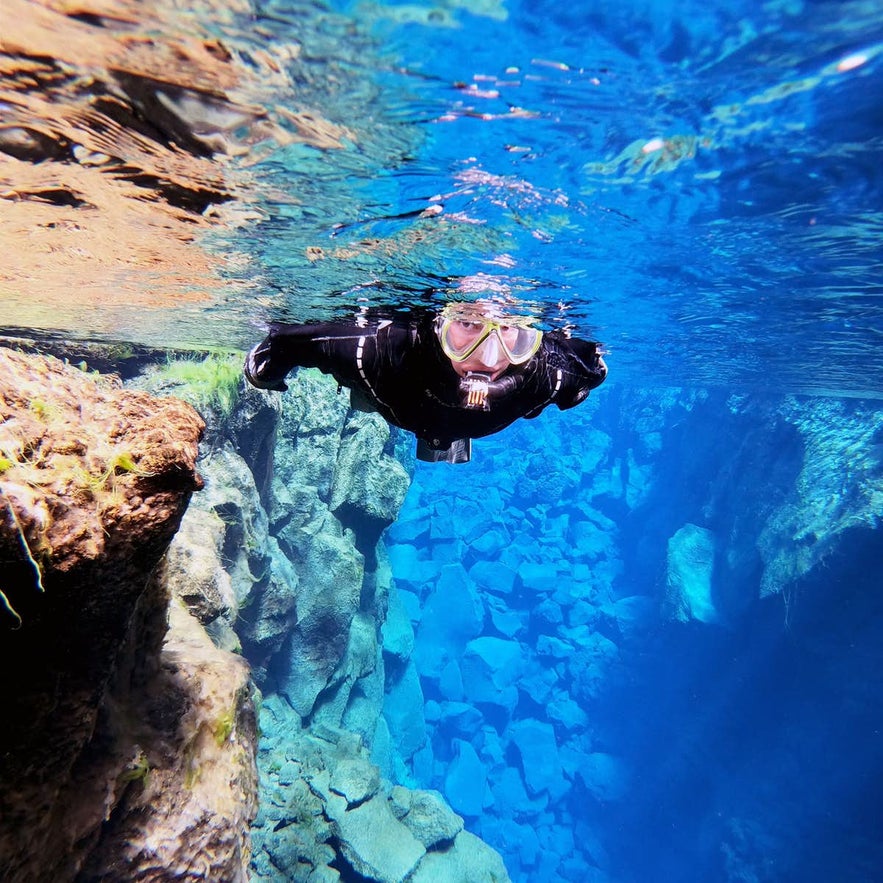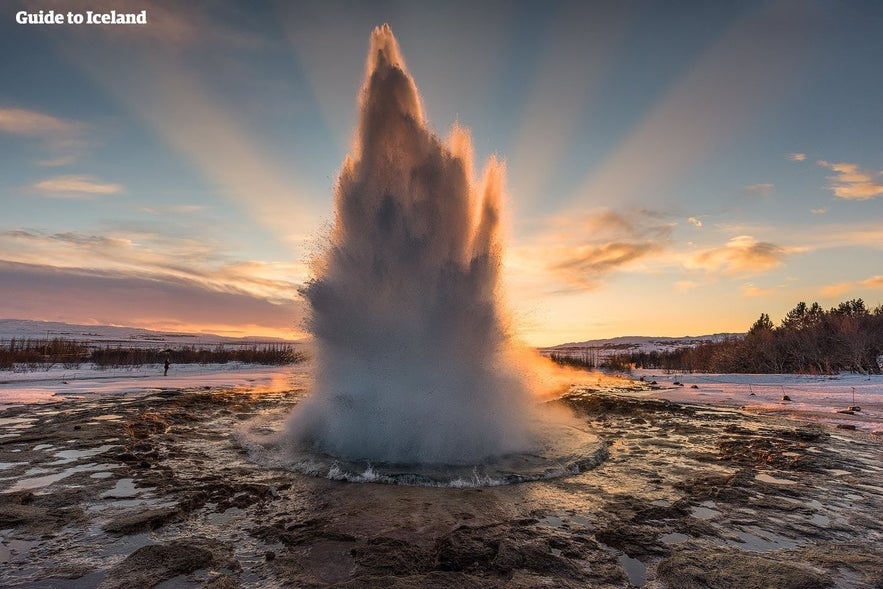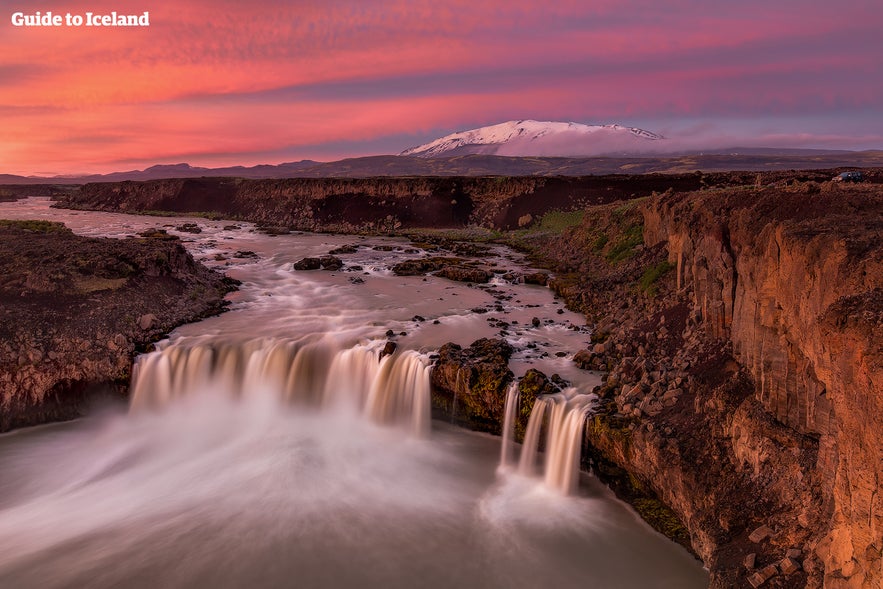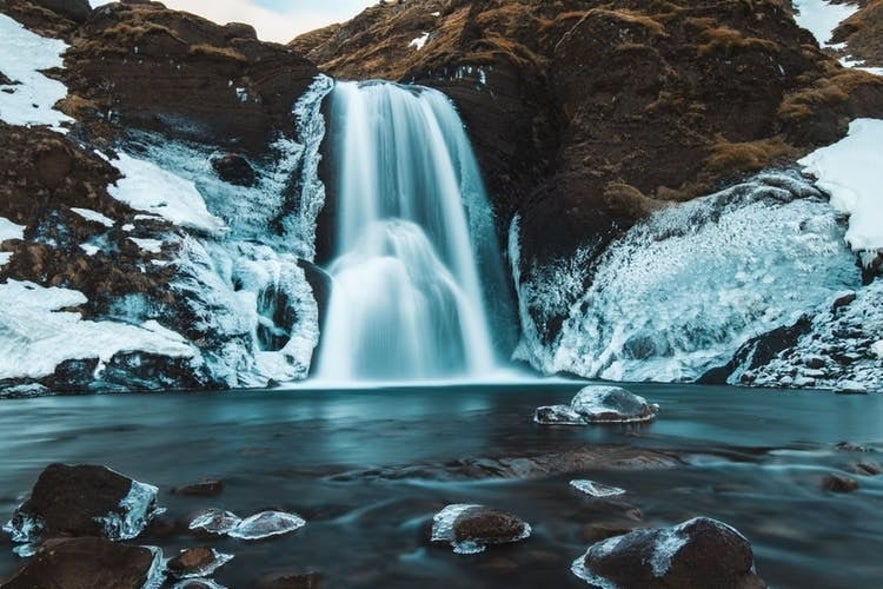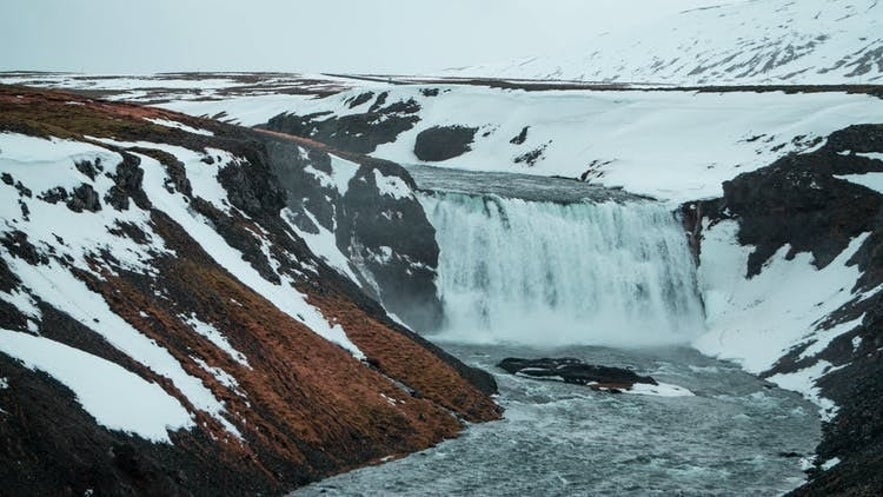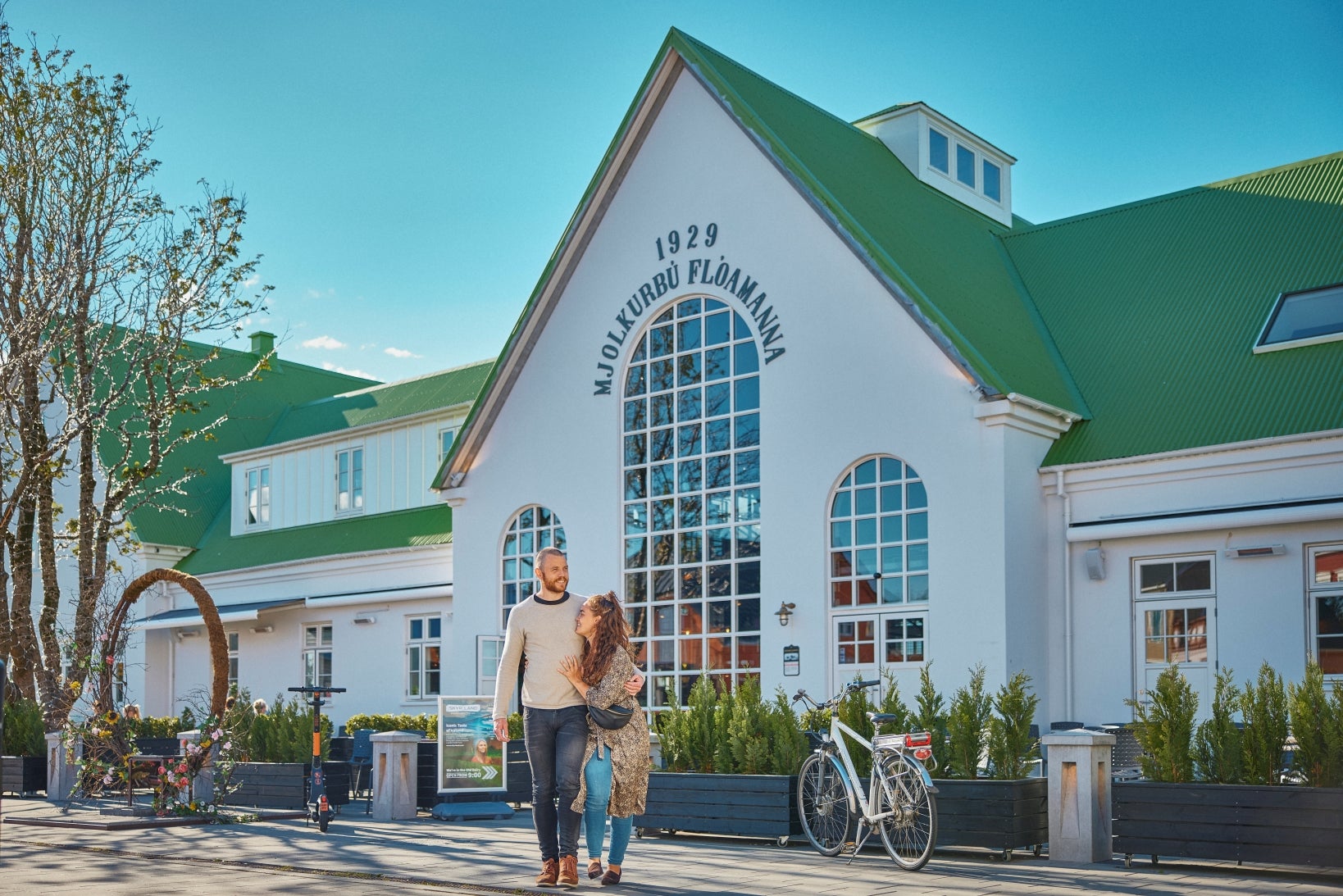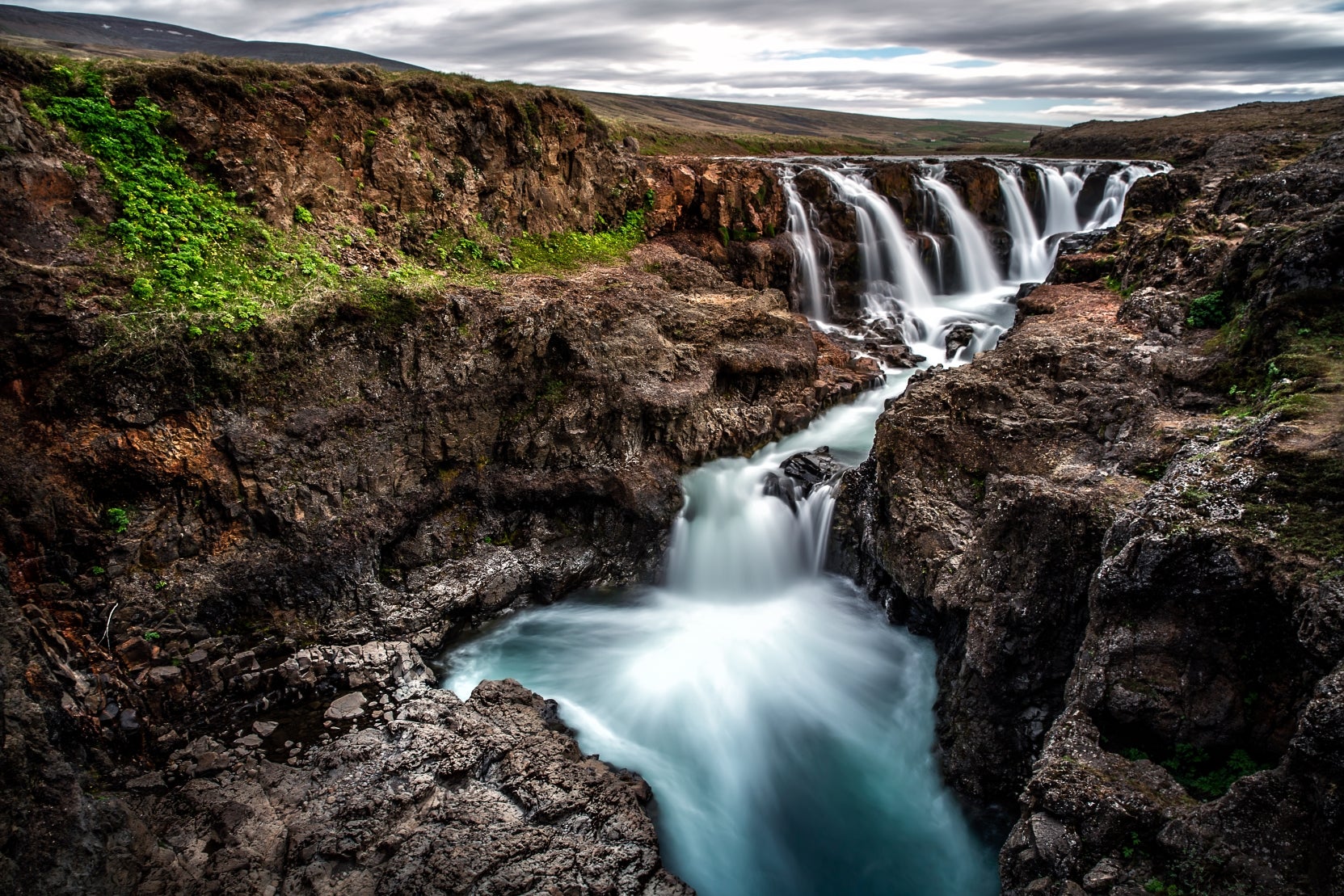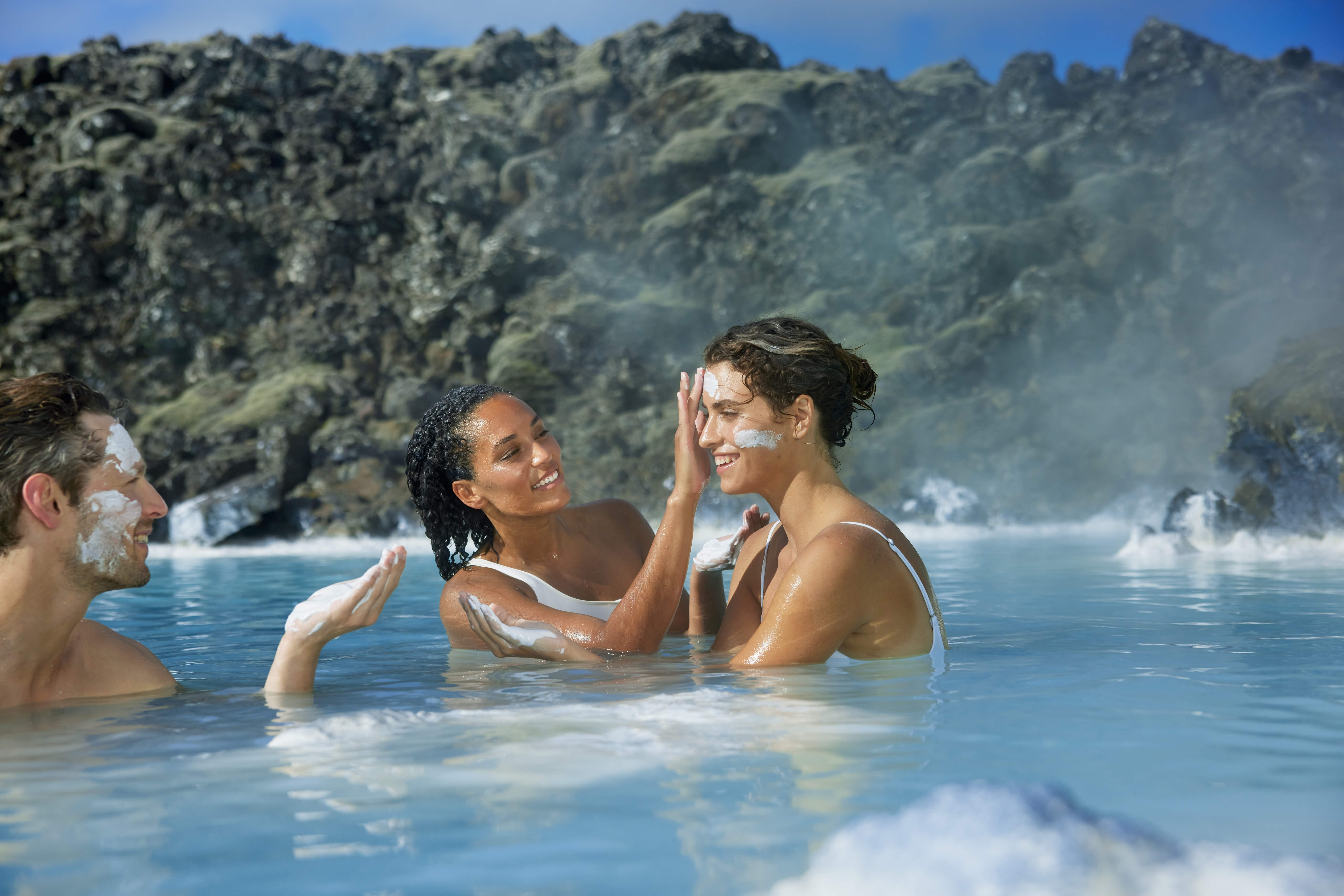Explore everything you need to know about Iceland's incredible Golden Circle route! Discover breathtaking natural wonders like erupting geysers, powerful waterfalls, and an impressive rift between two tectonic plates.
The Golden Circle is Iceland’s most popular sightseeing route, a 300-kilometer loop that takes you to three main landmarks: Thingvellir National Park, Gullfoss waterfall, and Geysir geothermal area.
Why You Can Trust Our Content
Guide to Iceland is the most trusted travel platform in Iceland, helping millions of visitors each year. All our content is written and reviewed by local experts who are deeply familiar with Iceland. You can count on us for accurate, up-to-date, and trustworthy travel advice.
The route is conveniently close to Reykjavik, and you can pair it with thrilling activities and excursions on Iceland's largest selection of Golden Circle tours to create your ultimate adventure in Iceland.
Join an excellent Golden Circle minibus tour from Reykjavik for a hassle-free way to experience these must-see destinations. Or, if you are looking for more action, choose a Golden Circle tour with snowmobiling on Langjokull glacier.
Although the route can be completed in a day, you can also find hotels near the Golden Circle if you prefer to take your time and stay longer in the area. There are plenty of extra activities you can add to your Golden Circle tour as well, such as visiting the nearby villages or even a volcanic crater!
Keep reading to discover the best way to explore the Golden Circle, including top sightseeing attractions, recommended detours, a detailed map, and top-rated Golden Circle tours—everything you need to plan your perfect adventure through Iceland's most famous route!
What Is the Golden Circle in Iceland?
The Golden Circle is the most famous route to take when visiting Iceland, and it consists of three equally stunning locations in Southwest Iceland:
The Golden Circle’s proximity to Reykjavík, its manageable 250 km (155 miles) loop, and short distances between attractions make it a must-visit for travelers exploring Iceland.
According to Dr. Agust Gudmundsson, a professor of geology and author of "The Glorious Geology of Iceland's Golden Circle (GeoGuide)", the Golden Circle provides a rare opportunity to witness the Earth's natural forces in action.
Dr. Gudmundsson said that these powerful forces drive the movement of tectonic plates, fracture the Earth's crust, and trigger earthquakes and volcanic eruptions. They also shape the landscape by carving channels for rivers and waterfalls and creating the heat sources that fuel hot springs and geysers.

To get the most freedom during your travels to the Golden Circle, car rentals in Iceland provide the flexibility to enjoy these sights at your own pace. Read on to discover what makes each location so incredibly unique:
Thingvellir National Park
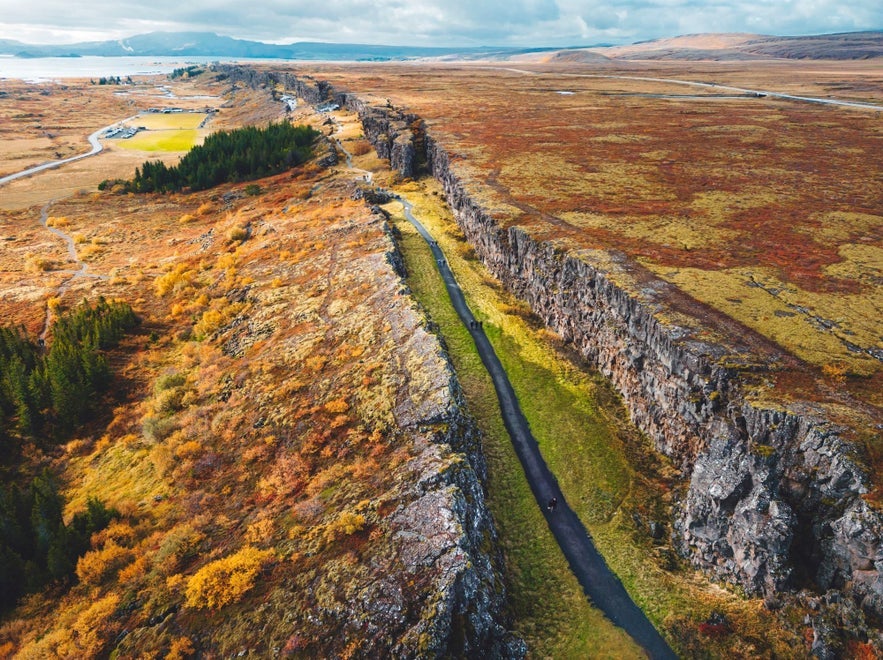
Thingvellir National Park is a unique site in Iceland as it's both historically significant and a geological wonder. It has the honor of being the first of Iceland's three national parks to be established. It's also the only one that has been granted UNESCO World Heritage Site status.
Considered the first stop on the Golden Circle, the park is only 29 miles (47 km) from Reykjavik. It's a place where dramatic geology meets a millennium of fascinating history. Here, visitors to Thingvellir can discover the roots of this island's formation and how the Icelandic settlers formed their leaderless society.

Iceland is the only country where this meeting place of the tectonic plates, the Mid-Atlantic Ridge, can be seen above sea level. Nowhere is it more visible than in Thingvellir National Park.
When you enter the park from Reykjavik, you'll drive towards a sheer cliff that is, in fact, a corner of the North American continent. The Eurasian continent is several miles away, on the far side of the park, and is equally dramatic to look at once you reach it.
A magma pocket formed between these plates, rising as they moved apart. This venting was responsible for creating Iceland millions of years ago.
Their continued separation is the reason that Iceland has such fascinating volcanic activity. The island as a landmass is still very young and still in its formation, which is why the land feels very much alive.
- Learn more about Tectonic Plates in Iceland and Where to Find Them.
- See also: Earthquakes in Iceland: The Ultimate Guide.
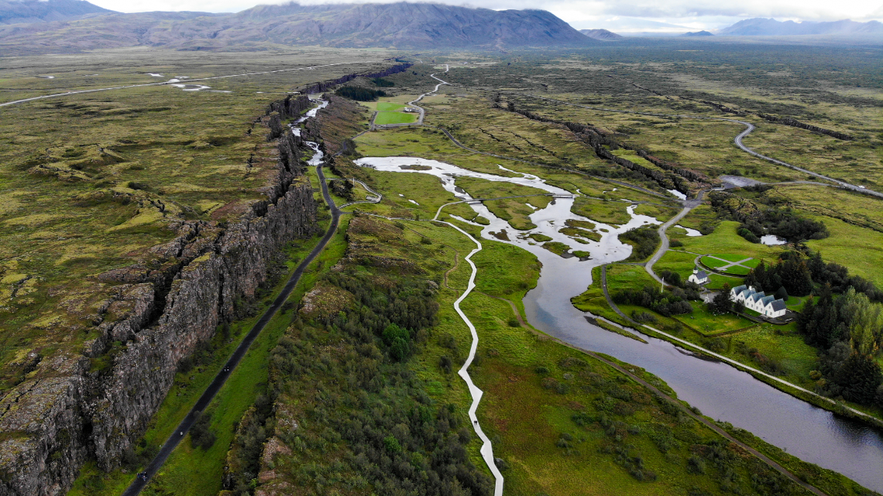 Visitors can find evidence of this process all across Thingvellir. The area consists of long stretches of lava rock, and many volcanoes surround the park, rising above Thingvallavatn, Iceland's largest natural lake.
Visitors can find evidence of this process all across Thingvellir. The area consists of long stretches of lava rock, and many volcanoes surround the park, rising above Thingvallavatn, Iceland's largest natural lake.
The park has grown over with vegetation since the last eruption, over 2,000 years ago. The beautiful, tender moss that creeps over the Icelandic landscape now covers the lava fields, while many parts of the area are forested with native birch trees and imported pines.
There are still regular earthquakes in the area, each one partly responsible for the distance between the plates widening approximately one inch (2.5 centimeters) a year.
The ravines opened by these quakes are filled with fresh water that melts from the Langjokull glacier and travels underground through the porous lava rock toward Thingvallavatn lake. This long filtration process means that when the water emerges from springs in these cracks, it's devoid of any sediment and crystal clear.
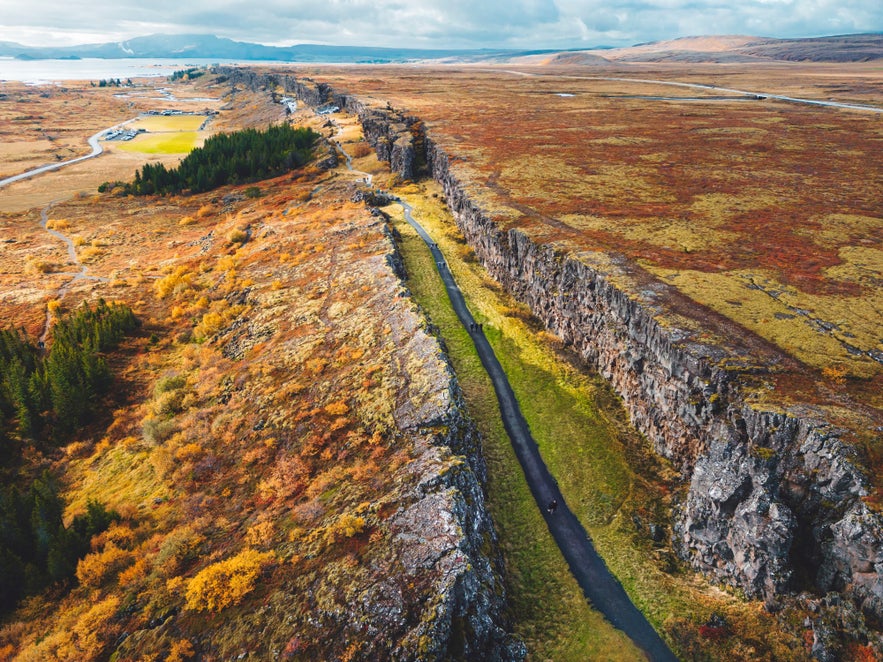 Visibility exceeds 330 feet (100 m), which makes walking through the area that much more scenic and makes for some magical opportunities for Icelandic diving tours and snorkeling excursions in Iceland.
Visibility exceeds 330 feet (100 m), which makes walking through the area that much more scenic and makes for some magical opportunities for Icelandic diving tours and snorkeling excursions in Iceland.
While these activities do not seem to befit Iceland's climate, dry-suit technology advancements mean that the 36 F (2 C) water is more than accessible, even during the winter.
Qualified guides take groups multiple times a day on this increasingly popular adventure through the most beautiful of these ravines, the Silfra fissure.
Snorkeling in Silfra is available to almost everyone over the age of 12 who knows how to swim. The dry suits are floatable enough to act as a life jacket, and Silfra has a gentle current that helps guests move through the fissure. Diving tours, however, require you to be a qualified PADI Open Water Scuba Diver and experienced in dry suit diving.
Silfra has been voted one of the top ten dive sites in the world. The underwater world here is incredibly beautiful, and the fact that guides conduct this Silfra diving tour between the tectonic plates makes it all the more exciting.
- Read more about Scuba Diving and Snorkelling in Iceland.

If you wish to see where the earth is tearing apart but want to stay fully dry, it's possible to walk in the Almannagja gorge. This stunning valley displays how the area's geological processes work and leads to a lovely waterfall called Oxararfoss. A free guided walking tour with a park ranger in Thingvellir is a great way to experience this area with expert insights. These tours start at the visitor center and Thingvallakirkja Church and are available daily from June to August.
When taking this hike, fantasy fans will notice some scenes from Game of Thrones that were shot in Iceland. The gorge was the shooting location for the path up to the Eyrie, where Arya Stark and Sandor "The Hound" Clegane journeyed through the Riverlands.
- For more, check out the Ultimate Guide to Game of Thrones in Iceland.
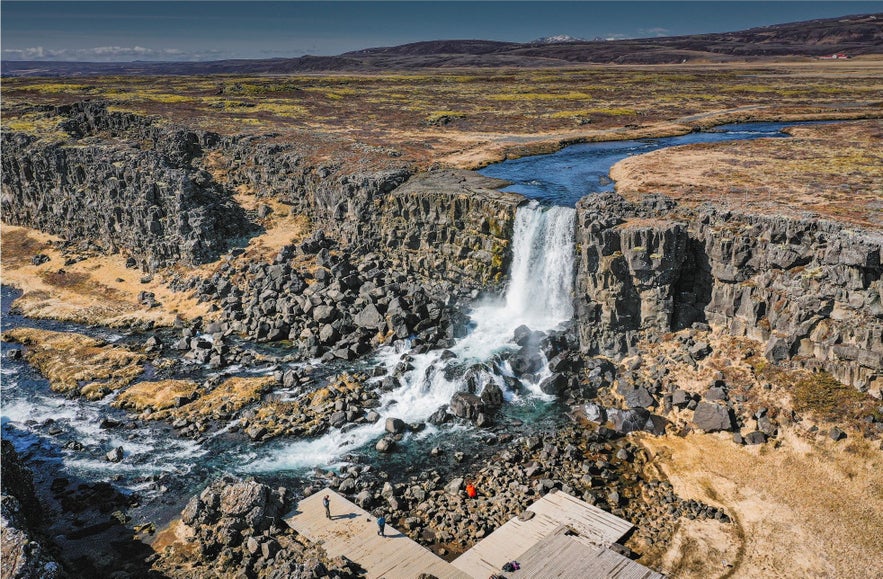 However, Thingvellir's incredible location and fascinating geology have nothing to do with why it received National Park and UNESCO World Heritage Site status. It received that title due to its compelling history!
However, Thingvellir's incredible location and fascinating geology have nothing to do with why it received National Park and UNESCO World Heritage Site status. It received that title due to its compelling history!
The first permanent settlers to Iceland arrived in the late 800s. They were largely Norsemen, many of which were fleeing from the growing centralization of power under King Harald Fairhair of Norway.
In 930 AD, they decided that some sort of collective government could ease disputes on the island, and each of the thirty or so groups present sent someone to represent them. They deemed their meeting place "the fields of assembly," which translates to Thingvellir.
This first assembly was so successful that the tradition continued year after year, decade after decade, and century after century, eventually evolving into the modern Icelandic parliament.
The institution endured after Norway took over the Icelandic Commonwealth in 1262 and transferred into the clutches of the Danish crown in 1380. Since its establishment over a millennium ago, the parliament was only interrupted for one period, from 1799 to 1844. After that, it was relocated to Reykjavik, but its function remained the same.
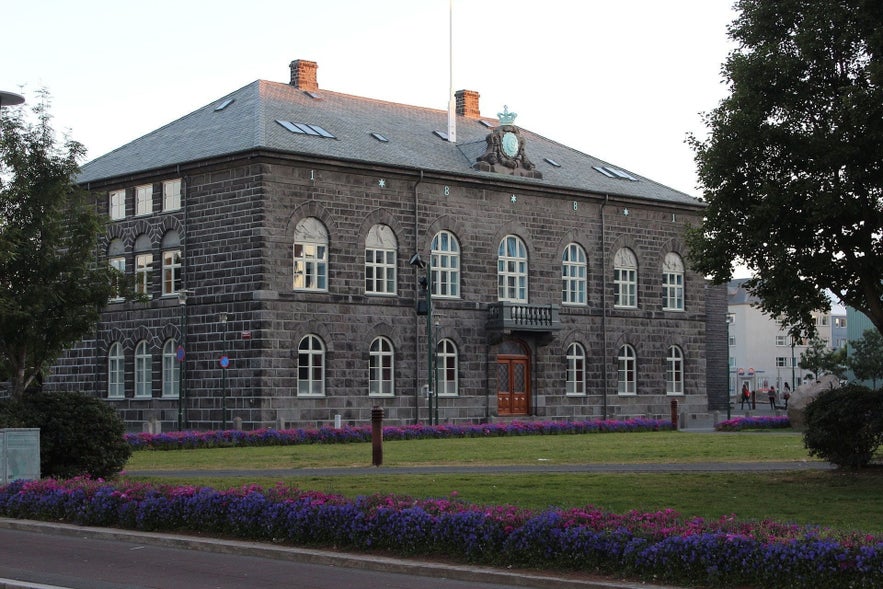
This history makes the Icelandic Althingi the world's oldest representative parliament that's still in session. While the populations of Europe endured feudalism without a thought to any democratic process, the "heathens" of Iceland created a representative system that would act as a model to many who followed it.
Because of these roots, Iceland declared Thingvellir a National Park in 1930, precisely 1,000 years after the assembly there. UNESCO eventually declared it a World Heritage Site in 2004. Not just for its natural beauty but because it was the most important site in Icelandic history for centuries, Thingvellir witnessed many significant changes as the nation developed.
 For example, the country converted to Christianity in 1000 AD, fearing the violence threatened by Norway's pious monarch, King Olaf I. It was also the site of many trials, executions, and other dramatic events detailed in the Icelandic sagas.
For example, the country converted to Christianity in 1000 AD, fearing the violence threatened by Norway's pious monarch, King Olaf I. It was also the site of many trials, executions, and other dramatic events detailed in the Icelandic sagas.
Even after the parliament site moved to Reykjavik, the area remained relevant to Icelanders. It was the ceremonial site of Iceland's declaration of independence in 1944 and where the parliament appointed the country's first president, Sveinn Bjornsson.
Thingvellir's history, combined with its beauty and geology, demonstrates why the park is such a popular destination. It is, however, only one of three iconic sites on the classic Golden Circle route.
- Learn more: A Complete History of Iceland.
The Geysir Geothermal Area
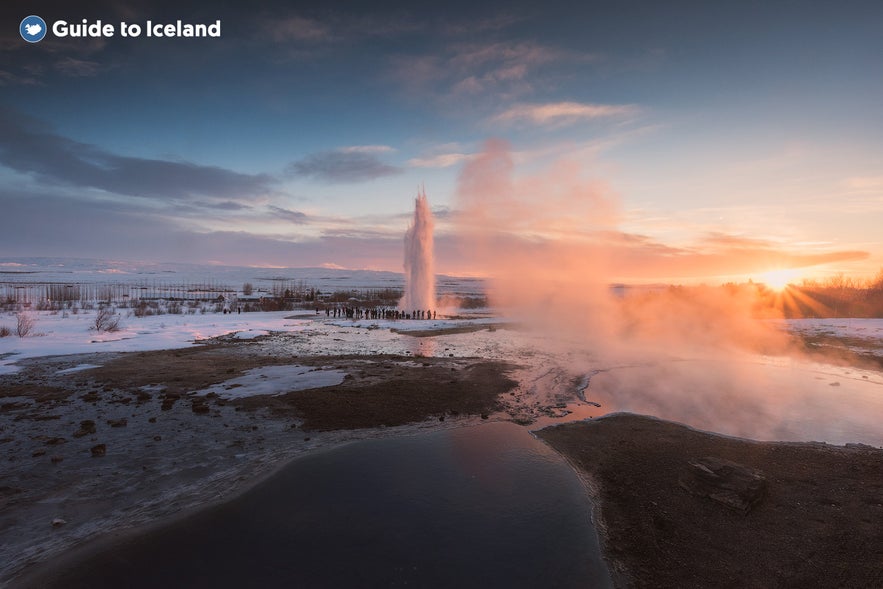 The second stop on the Golden Circle is the impressive Geysir Geothermal Area, located within the Haukadalur valley, only a short 37-mile (60-km) drive from Thingvellir National Park.
The second stop on the Golden Circle is the impressive Geysir Geothermal Area, located within the Haukadalur valley, only a short 37-mile (60-km) drive from Thingvellir National Park.
Steaming vents and chimneys are visible along the way and notably concentrated in the village of Laugarvatn, located halfway between Thingvellir and Geysir.
This settlement has the Fontana spa, which is heated by hot water currents beneath the ground's surface. Its steam rooms sit on top of bubbling hot springs that reach a sweltering 140 F (60 C).
However, at Haukadalur Valley, this geothermal activity becomes even more intense. Visitors can see the steam rising from miles away. Many hot pools, clay pots, and fumaroles dot the area. Minerals vividly color the hills and soil.
It would be a fascinating enough site even without the two geysers that make it famous. The first of these is the one that gave all others their name: the Great Geysir.
Geysir is the earliest documented geyser in European literature, and its name comes from the Old Norse verb "to gush." Geysir rarely erupts anymore, but its neighbor, Strokkur geyser, goes off every ten minutes, throwing water from 66 to 132 feet (20 to 40 m) into the air.
The original Geysir is primarily inactive these days because of local tectonic activity and intrusive human intervention. Studies show that it has existed for about 10,000 years and tends to erupt in cycles. Usually, an earthquake will trigger it, and it will then slowly peter out over time.
However, even when it's erupting, it's unpredictable in both timing and consistency. For example, in the early 1910s, it was known to erupt every half-hour, yet its activity had almost ceased by 1916.
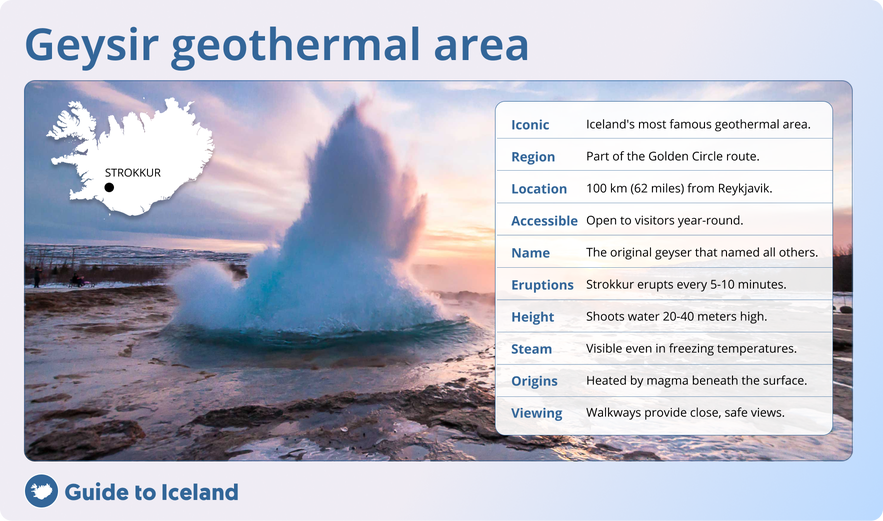
Although it worked for a short time, the channel became clogged, and activity ceased once more. The channel was cleared in 1981, and it was found that Geysir could be made to erupt on occasion by pumping soap into it. There were many concerns about this activity's environmental impact, and it was stopped in the 1990s.
Geysir has been mostly dormant since then, though it still goes off occasionally, giving the lucky a chance to catch sight of it. When it does erupt, it's much larger than Strokkur.
In 2000, Geysir spewed water 400 feet (122 meters) into the air. The only time it was recorded blasting higher was in 1845 when it reached an estimated 558 feet (170 meters).
The reliability of the highly active Strokkur in such an accessible location is part of what makes the Golden Circle so incredible. Geysers are a rare natural phenomenon due to the specific conditions required for their formation.
For a geyser to exist, it requires the following circumstances:
-
An intense heat source: For geysers to erupt, magma must be close to the earth's surface to heat rocks hot enough to boil water.
-
Water flow: There must be a source of flowing underground water. In this case, the water is runoff that melted from the Langjokull glacier and traveled through porous lava rock into the area.
-
A natural plumbing system: There must be an underground reservoir for water to gather and a vent lined with silica so that the water cannot seep out of it before rising from the reservoir to the surface.
Walking around the Geysir Geothermal Area is a fascinating and rewarding experience, but its appeal goes further than these exploding hot springs.
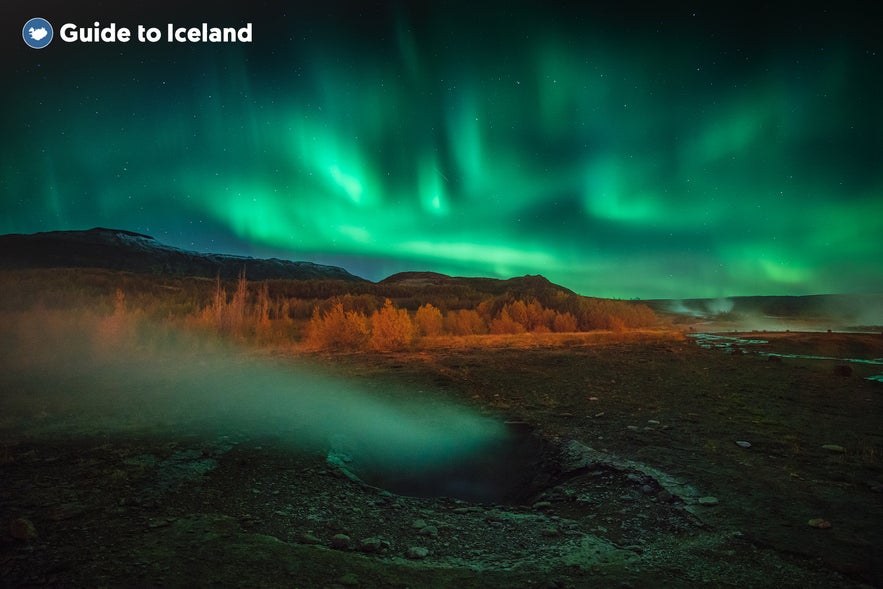 The Geysir Center, just opposite the geothermal area, has a large shop with incredible souvenirs, clothing, and famous Icelandic brands. The center also has several restaurants serving Icelandic food made from local ingredients and a five-star accommodation, Hotel Geysir.
The Geysir Center, just opposite the geothermal area, has a large shop with incredible souvenirs, clothing, and famous Icelandic brands. The center also has several restaurants serving Icelandic food made from local ingredients and a five-star accommodation, Hotel Geysir.
The Haukadalur Valley is an incredible place to stop and marvel at nature. Be sure to respect the area and do not throw anything into the hot springs or geysers. The best way to experience this top attraction in Iceland is by joining a Golden Circle Tour from Reykjavik.
Gullfoss Waterfall
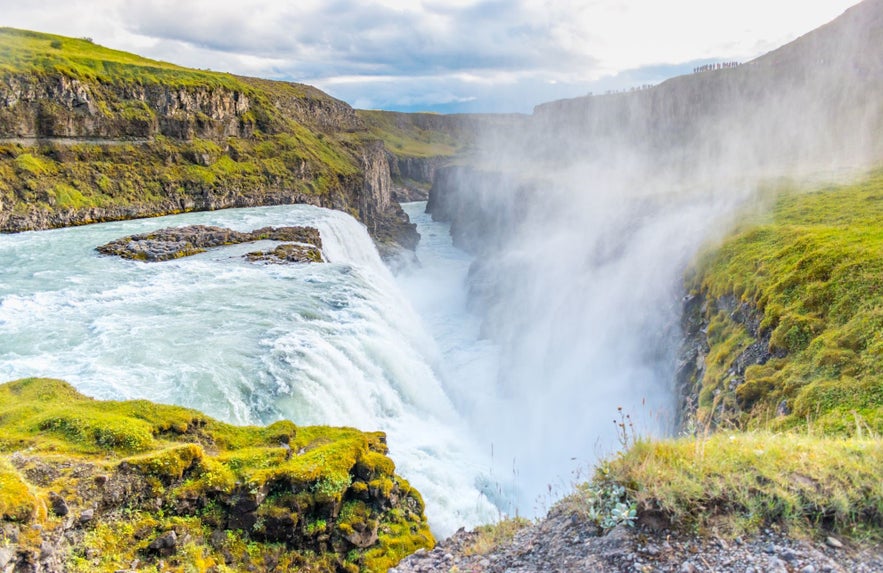 The third and final stop on the route of the Golden Circle is one of the most spectacular waterfalls in Iceland: Gullfoss. This is the landmark from which the Golden Circle draws its name, as Gullfoss directly translates to "Golden Falls." The waterfall is located less than 6 miles (10 km) from Geysir.
The third and final stop on the route of the Golden Circle is one of the most spectacular waterfalls in Iceland: Gullfoss. This is the landmark from which the Golden Circle draws its name, as Gullfoss directly translates to "Golden Falls." The waterfall is located less than 6 miles (10 km) from Geysir.
This powerful waterfall is located in a plunging, ancient valley and tumbles down two drops from an overall height of 105 feet (32 m). During its heaviest flow in the summer, it pours an average of 4,944 cubic feet (140 cubic meters) of water every second.

These only add to an already beautiful sight. In addition to the dramatic valley and falls, the area looks over rolling fields right up to the magnificent ice sheet of the Langjokull glacier.
Like the springs in Thingvellir and the water at the Geysir Geothermal Area, the river flows down Gullfoss from Langjokull. The river is called Hvita, and it is a popular spot for river rafting tours in Iceland during the summer months.
- Check out the Ultimate Guide to River Rafting in Iceland.
Summer is arguably the best season to visit Gullfoss. When there's no ice on the ground, a walkway takes you right up to the edge of the falls, close enough to feel the waterfall's mist on your face.
The photo opportunities here are incredible, and one could spend hours marveling over the awe-inspiring power of the water. However, that is not to say that Gullfoss is any less spectacular in the winter.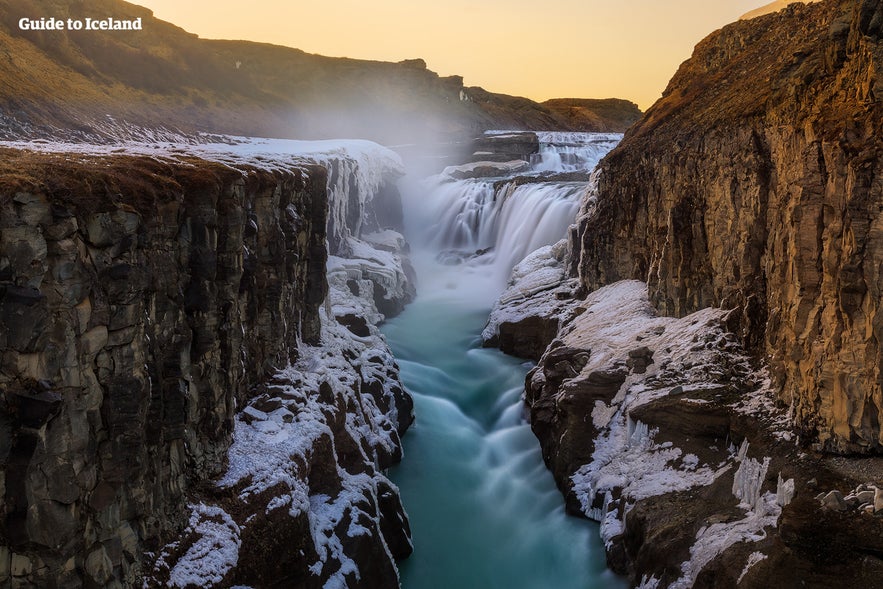
While you cannot get as close, seeing it partially frozen and carrying chunks of ice into the abyss is mesmerizing. If you visit in winter, be sure to wrap up in warm layers. The winds coming over the glacier are notoriously sharp, and the mist spraying off the waterfall is icy cold.
Gullfoss today is an attraction that captivates people from across the world, and without it, Iceland's tourism industry would not be the same. Therefore, it's incredibly fortunate that it's well-preserved and has not been meddled with in any way.
After all, protecting nature in Iceland has not always been everybody's intention. In the early 20th century, foreign investors saw a huge opportunity to add a dam to Gullfoss and turn it into a hydroelectric plant.
 The owner of the land adjacent to the falls, Tomas Tomasson, had allowed British investors to explore building a dam there. These plans started to go ahead against his wishes but became incredibly difficult to enforce when Tomas's daughter entered the picture.
The owner of the land adjacent to the falls, Tomas Tomasson, had allowed British investors to explore building a dam there. These plans started to go ahead against his wishes but became incredibly difficult to enforce when Tomas's daughter entered the picture.
This great environmentalist, named Sigridur Tomasdottir, refused to allow the destruction of the natural wonder she loved so much.
She did everything she could to preserve it, from threatening to throw herself into the falls to walking the 134 miles (200 kilometers) of unpaved road to Reykjavik and back again multiple times to build a legal case in Gullfoss's defense.
Although her actions did not directly save the waterfall, they drew attention to the case. This awareness led to national criticism of the plans and ensured that the dam-building process was delayed.
Eventually, Sigridur enlisted Sveinn Bjornsson, a respected lawyer, in her protests, who managed to work with the investors (who lacked the money to take action) and persuaded them to annul the contract. Sveinn Bjornsson would, in 1944, become the first president of Iceland.

Photo from Wikimedia, Creative Commons, by Ralf Roletschek.
Today, Sigridur is immortalized in a stone memorial on top of the cliff overlooking the waterfall. Icelanders remember her for bringing awareness to the importance of preserving Iceland's nature and not being tempted by foreign investments. Her actions eventually helped preserve Gullfoss so that all of us could marvel at its beauty to this day.
The Top 6 Best Golden Circle Itineraries and Tours

The Golden Circle route is one of the most popular trails in Iceland, with thousands of people exploring it over the years. These are the top 6 Golden Circle itineraries, rated as the best by visitors:
-
Golden Circle & Snowmobiling Tour with Transfer from Reykjavik: If you're looking for adventure on a budget, this affordable tour stops at all the best Golden Circle attractions. This tour includes a stop for a snowmobile trip across the majestic Langjokull glacier, the second-largest glacier in Iceland.
-
Three-Day Northern Lights Trip in Iceland with the Golden Circle, South Coast & Glacier Experience: This 3-day tour is the best way for you to make all of the must-see Golden Circle stops and fit in two of Iceland's most iconic activities: exploring the famous ice caves and hiking across expansive glaciers.
-
Small-Group Golden Circle Minibus Tour from Reykjavik with Bruarfoss Waterfall & Kerid Crater: This intimate small-group tour will take you to all of the most popular Golden Circle attractions with an added leisurely stop for a tasty treat at a local ice cream farm in Efstidalur valley.
-
The Golden Circle & Blue Lagoon Tour with Transfer from Reykjavik: This day tour is perfect for exploring the Golden Circle's top attractions, including Thingvellir, Gullfoss, Geysir, Kerid crater, and the Blue Lagoon, make the most of a full day in Iceland.
-
Amazing 5-Day Northern Lights Winter Vacation Package in Iceland with Ice Caving & the Blue Lagoon: This 5-day winter package takes you to Iceland's top attractions, including the Golden Circle, South Coast, Blue Lagoon, and a rare natural ice cave in Vatnajokull National Park. Enjoy guided tours, accommodations, and transportation, with optional activities like snowmobiling.
-
Horse Riding Trip in the Golden Circle: Explore Iceland's landscapes on a one-hour horse riding tour at Syðra Langholt, perfect for all ages and skill levels. Ride through beautiful hills and lava fields on Icelandic horses, guided by experts. Enjoy a family-friendly adventure complete with all necessary equipment and a personal interaction with the gentle horses.
The Classic Golden Circle Route Map
There are several ways to explore the Golden Circle. This map details the fastest and simplest Golden Circle route. Below, you can find more notable attractions along the way.
Top 12 Detours Along the Golden Circle
Regardless of your time in Iceland, budget, or travel plan, it's nearly always possible to fit in a trip around the Golden Circle.
The incredible diversity of scenery available within a simple drive makes it an essential Icelandic experience for any traveler. Therefore, it's advisable to rent a car in Iceland and explore the area near the Golden Circle.
If you elect to drive the circle yourself, there are many detours you can take to fascinating sites along the way. Most of these are lesser-known, so you can combine the classic Golden Circle route with visits to these off-the-beaten-track attractions.
Below are the top eleven lesser-known Golden Circle highlights you should consider.
- Check out the Best Advice For Renting a Car in Iceland.
- Also, see the Best Guide to Rental Car Sizes in Iceland.
12. Hraunfossar and Barnafoss Waterfalls
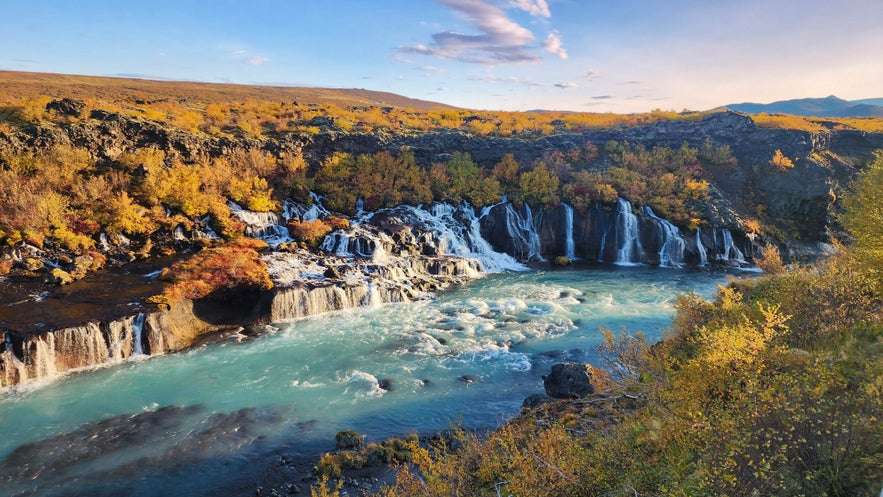 Hraunfossar, often referred to as the "Lava Waterfalls," is a natural treasure described as a collection of countless creeks and cascades that stream out of the Hallmundarhraun lava field over a distance of about 900 meters.
Hraunfossar, often referred to as the "Lava Waterfalls," is a natural treasure described as a collection of countless creeks and cascades that stream out of the Hallmundarhraun lava field over a distance of about 900 meters.
These waterfalls are fed by waters emerging from the porous lava rock, not from a typical river or stream. The scenic view is enhanced by the glacier Langjökull in the background, adding a dramatic touch to the landscape. The water varies in color from a dazzling turquoise to a milky white, depending on the conditions, which makes Hraunfossar a photographer's paradise.
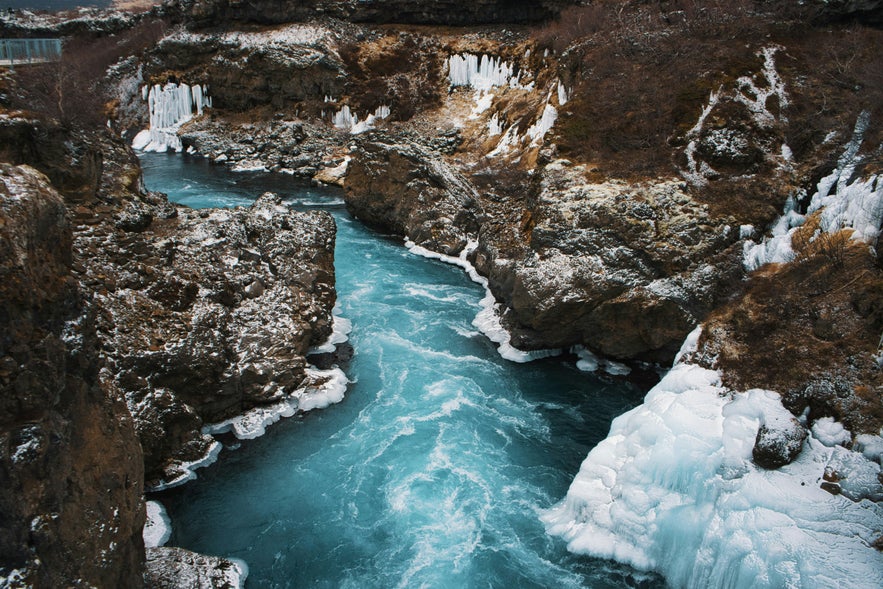 Just upstream from Hraunfossar, Barnafoss, which translates to "Children's Waterfall," has a more haunting backstory.
Just upstream from Hraunfossar, Barnafoss, which translates to "Children's Waterfall," has a more haunting backstory.
The name comes from a tragic legend about two children who fell into the falls and drowned, leading their mother to destroy the stone arch that crossed the river, vowing that no one else would suffer the same fate. This story adds a layer of cultural depth to the site, making it not just a natural attraction but also a place of local history.
You can visit these both the Hraunfossar and Barnafoss waterfalls on a day trip if you rent a car in Iceland.
11. Skalholt Town
 Photo from Wikimedia, Creative Commons, by Qasmed. No edits were made.
Photo from Wikimedia, Creative Commons, by Qasmed. No edits were made.
Skalholt is a remarkable historical town in Iceland. It was one of the seats of Iceland's two bishops from 1056 and remained so until the 19th century. To put that in context, the bishop of Iceland was in the most powerful position in the country when Iceland was ruled by foreign kingdoms in Scandinavia. The position of bishop far exceeded just attending to religious matters. Therefore, Skalholt was a very important seat of power in Iceland for centuries.
By the year 1200, it was considered Iceland's first town, with a population of 120 people. Skalholt was also the site of Iceland's first school, established in the 12th century. Today, it has an ordained bishop who hosts many cultural events.
You can find Skalholt on Route 31, just off Route 35, from the Geyser geothermal area to Reykjavik. If you are driving through Skalholt, its cathedral alone is worth a stop.
10. Thjorsardalur Valley
If you wish to explore some more hidden gems and do not mind a bit of extra driving, a detour to Thjorsardalur valley only takes a couple of hours.
Thjorsardalur valley is part of the southern Highlands of Iceland. It boasts a wide range of incredible natural sites. Here, you can find a wealth of beautiful waterfalls that most never get to visit, such as Haifoss and Granni.
Thjorsardalur is quite the botanist's paradise, with many wildflower species, grass, and moss growing in the area. To get there, drive south on Route 30 from Gullfoss, then take a left turn onto Route 32.
- Discover these 20 Hidden Gems in Iceland: Go Off-the-Beaten-Path.
- See also Haifoss, Granni & Hjalparfoss - the beautiful waterfalls at the Fossa River in Iceland.
9. Solheimar Eco-Village
The unique Solheimar eco-village has a population of approximately 100 people.
Formed in 1930 by Sesselja Sigmundsdóttir as a self-sustaining settlement for orphans and children with learning disabilities. It has always been a unique place with a distinct philosophy of maximizing every person's potential, irrespective of age or ability.
Over the past few years, its charm and quirky vibe have drawn more and more visitors. Now, over 30,000 people stop by every year to see what it's all about.
The settlement - nestled seamlessly in nature - has everything visitors could need, with a bakery, cafe, guesthouse, and art gallery, all operated by the town's residents.
The gift shop at Solheimar has hand-made souvenirs made in the town's art workshop, where residents can engage in candle-making, weaving, and ceramics.
It's also home to the Sesselja House. An educational exhibition center focused on ecology and sustainable development.
Solheimar is a 13-mile (21-km) drive south of Laugarvatn, so it's ideally located to visit as part of an extended Golden Circle self-drive tour. It is a different type of attraction with an atmosphere of positivity and freedom that's truly unique.
8. Helgufoss and Thorufoss Waterfalls
Some of Iceland's most incredible waterfalls are close to the Golden Circle. The classic route takes you to Gullfoss waterfall, though other lesser-known waterfalls nearby are well worth visiting.
Two stand-out options are Helgufoss Waterfall and Thorufoss Waterfall, both named after the Icelandic female names Helga and Thora.
Helgufoss waterfall is located just off Route 36, on the way to Thingvellir from Reykjavik.
Meanwhile, Thorufoss waterfall forms part of the river Laxa i Kjos and can be visited by following Route 48 after Helgufoss before reaching Thingvellir National Park. The waterfall is signposted, and there's a small area on the side of the road where you can park your car.
You'll need access to a rental car to visit both waterfalls, as Golden Circle tours don't typically visit these remote locations.
7. Fridheimar Tomato and Horse Farm
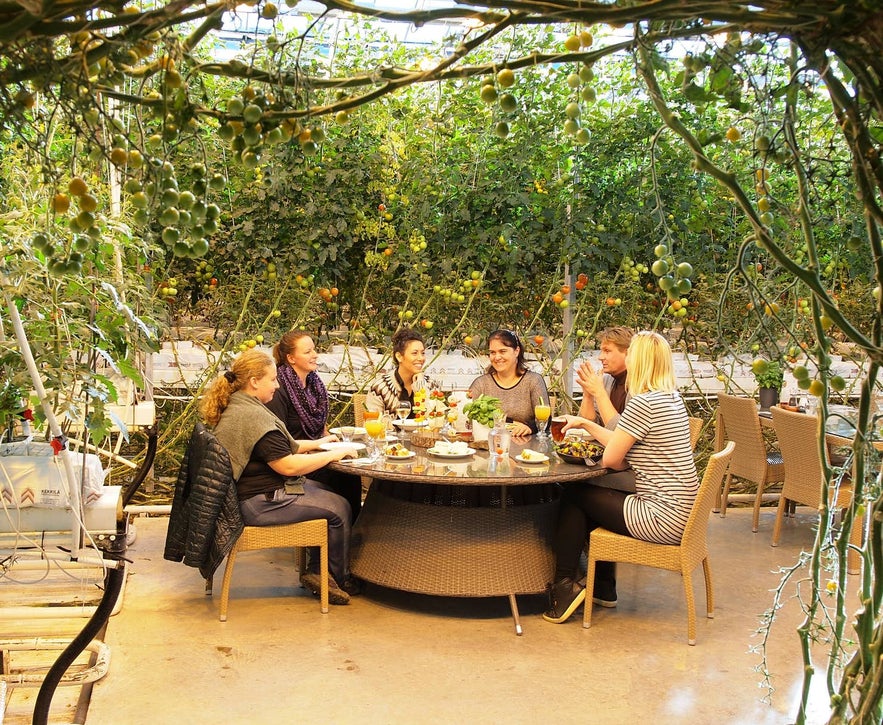
Fridheimar is a tomato, cucumber, and horse farm located on Route 35. The farm is the perfect place to stop for lunch between noon and 4 PM. Here, you can enjoy some delicious tomato soup with home-baked bread.
It has become the go-to spot for lunch when exploring the Golden Circle, so make sure to reserve your table at Fridheimar with good notice. It's unlikely that you'll get a seat with no booking, though it's worth a try!
You'll also need to book in advance if you would like to enjoy a farm tour or go to a horse show. Fridheimar is one of Iceland's most underrated locations, and it's well worth a visit.
6. Bruarfoss Waterfalls
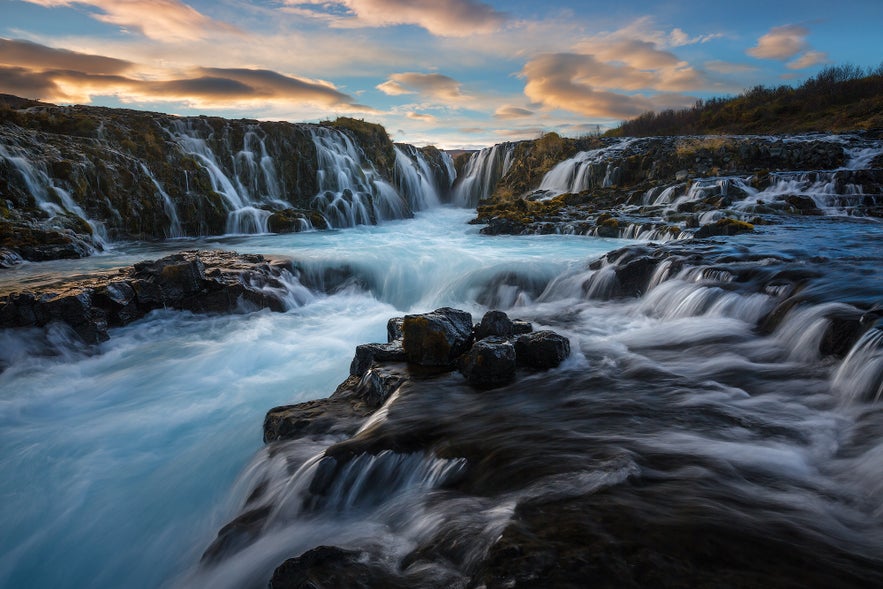
If you’re looking to add a less-touristy detour along the Golden Circle, Bruarfoss Waterfall is a hidden gem worth visiting. It is tucked between Thingvellir National Park and Geysir, making it an easy side trip. Bruarfoss is often called “Iceland’s Bluest Waterfall” and offers a peaceful moment surrounded by nature.
Glacial melt from Langjokull feeds the waterfall, giving it a clear, icy blue color unlike any other in the area. A wooden bridge offers the best view over the ribbon-like cascades flowing through a narrow gap in the dark volcanic rock.

There are two simple ways to reach Bruarfoss. If you prefer an easy option, drive to the nearby Bruarfoss Parking area. From there, it’s just a 5-minute walk to the viewing platform. This route is suitable for all visitors and doesn’t require any hiking.
If you’d like a bit more adventure, take Route 37 and turn left at the Bruarfoss Trail – Parking. From here, it’s an easy, mostly flat hike of around 2.2 miles (3.5 kilometers) along the Bruara River. Along the way, you’ll pass by Hlauptungufoss and Midfoss Waterfalls, making the hike even more rewarding.
Be sure to enjoy the view from the designated platform or bridge; approaching the waterfall directly can be dangerous due to slippery rocks and fast-moving water. Staying on the marked paths helps preserve the area and keeps you safe during your visit.
As a detour from the Golden Circle, a visit to Bruarfoss can take as little as 30 minutes or up to 2.5 hours, depending on how you choose to experience it. The shorter route is ideal for travelers on a tight schedule, while the longer hike appeals to those who want a quiet, scenic walk.
5. Snowmobiling on Langjokull Glacier

The most popular option is to combine a Golden Circle tour with snowmobiling on the Langjokull glacier. It's also possible to book this snowmobiling tour at Langjokull Glacier or upgrade to this tour, which also visits a stunning ice cave.
Langjokull isn't far from Gullfoss waterfall, where the tour operators will pick you up for the snowmobiling excursion. On a clear day, you'll have a fantastic view from the glacier, and the ride up to the glacier in a giant customized super-jeep is an adventure in itself. This excursion is not to be missed by adventurous travelers.
4. Secret Lagoon in Fludir
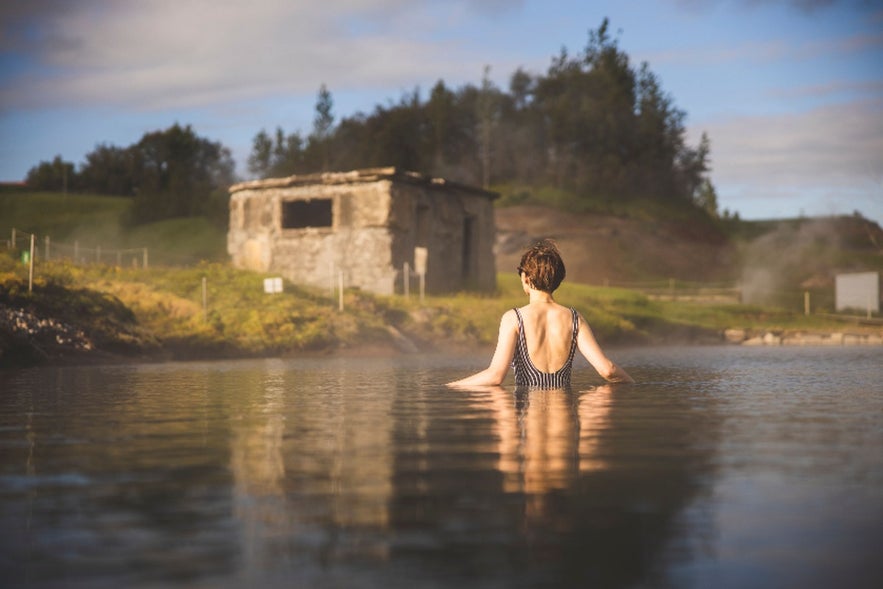
The Secret Lagoon, or "Gamla Laugin," at the Fludir village is a great place to relax and renew your energy after a busy day of sightseeing.
It's the oldest swimming pool in Iceland and was built in 1891. The pool's temperature is 100-104 F (38-40 C) year-round, sustained by the water entering it from the surrounding natural hot springs.
There's also a walking path around the swimming pool for guests to admire this geothermal area.
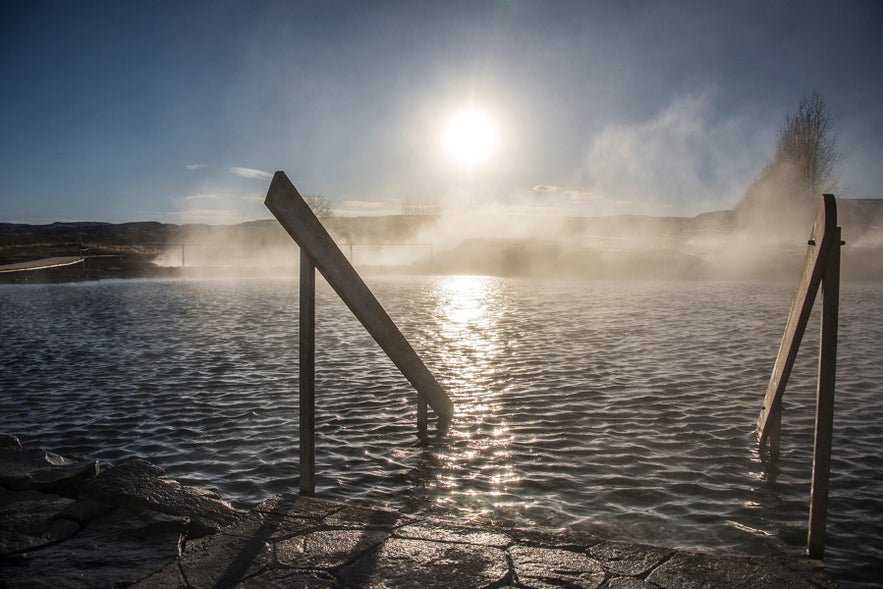 The pool hosted swimming classes from 1909 until 1947, but it fell into disrepair as new pools opened around the country. However, it has recently been renovated and modernized, with new changing facilities and a cafe. It reopened in June 2014.
The pool hosted swimming classes from 1909 until 1947, but it fell into disrepair as new pools opened around the country. However, it has recently been renovated and modernized, with new changing facilities and a cafe. It reopened in June 2014.
Be aware that if you wish to visit this location, it's always best to book in advance, as it's growing in popularity.
Fludir is on Route 30. It can be easily visited by car or on this Golden Circle and Secret Lagoon tour.
3. Kerid Crater

You can include this location by going on this full-day Golden Circle tour with the Kerid crater, and if you're driving, you shouldn't miss out on this natural wonder either. The crater was formed about 6,500 years ago and is oval-shaped, with a lake at its bottom.
The rocks surrounding the crater are fiery red and orange, with streaks of black and green running through them. These colors contrast beautifully with the azure waters.
Due to its shape, Kerid is renowned for its acoustics, and artists sometimes hold concerts there, floating on a boat in the middle of the lake. This crater is situated on Route 5, close to the town of Selfoss. It also has a small parking lot next to it. Please note that there's a small admission fee for entering Kerid.
2. Fontana Geothermal Baths

Fontana Geothermal Baths is the name of a spa in the town of Laugarvatn, on the way from Thingvellir National Park to Geysir.
Laugarvatn is a picturesque village perched on the edge of a vast lake renowned for its geothermal activity. Locals have enjoyed this area since 1929, though the current spa was opened in 2011.
Fontana features three steam rooms and a traditional wooden Finnish sauna with fantastic views of the lake and surrounding nature. There are also plenty of shallow pools that vary in heat, allowing kids to enjoy the water while the adults can relax.
The Fontana Geothermal Baths open out onto the lake, where it's possible to feel warm water rising from the earth between your toes.
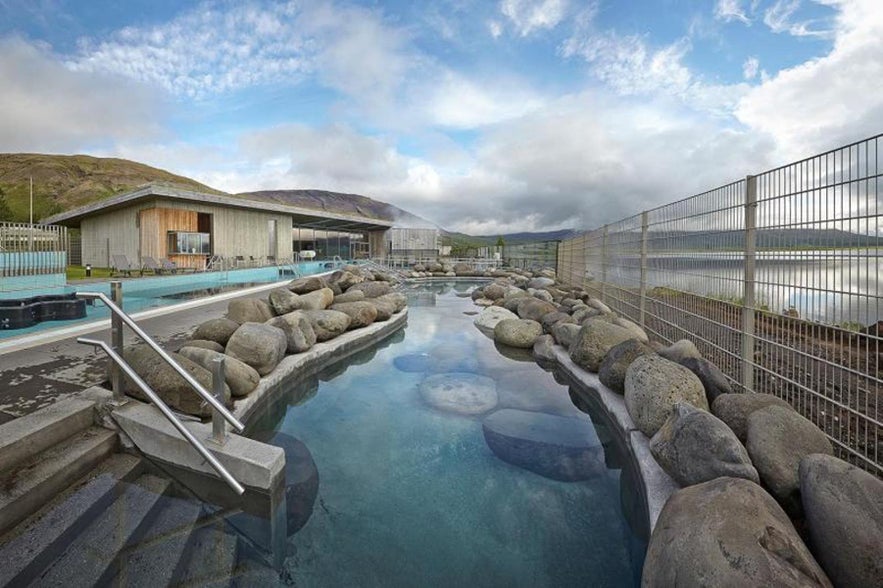
If you stop here, make sure to try the rye bread that the spa bakes for 24-hours in the hot sand. Hot, freshly baked rye bread with butter is as traditionally Icelandic as it is delicious.
You can enjoy both this site and the surrounding attractions on this Golden Circle and Fontana Geothermal Baths day tour.
1. Laugaras Lagoon
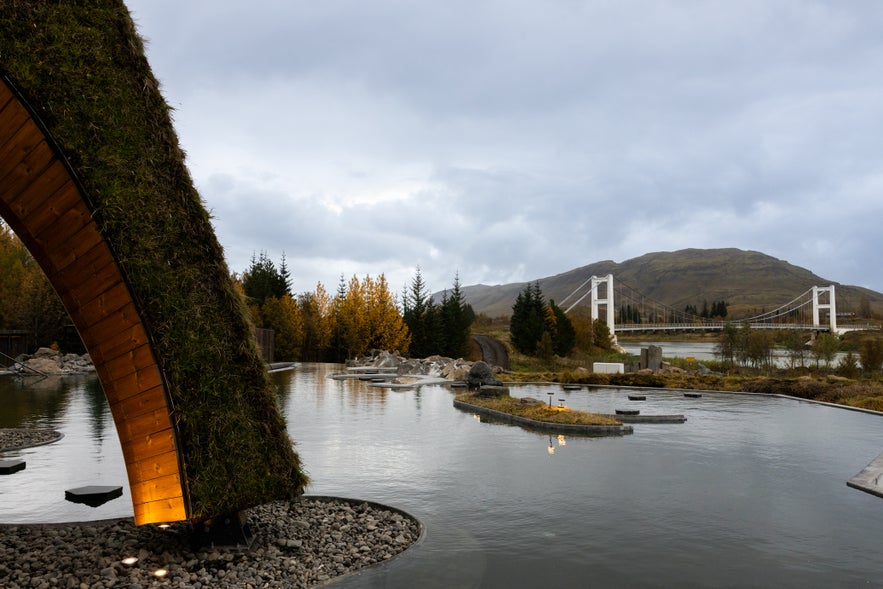 If you want to add a relaxing detour along the Golden Circle, Laugaras Lagoon is a new geothermal spa in Iceland that’s easy to fit into your trip. It sits by the Hvita River, surrounded by birch trees and farmland, just a 10-minute detour off the main sightseeing route.
If you want to add a relaxing detour along the Golden Circle, Laugaras Lagoon is a new geothermal spa in Iceland that’s easy to fit into your trip. It sits by the Hvita River, surrounded by birch trees and farmland, just a 10-minute detour off the main sightseeing route.
The lagoon blends comfort and nature to create a peaceful, less-crowded spa experience. Unwind in the infinity pool, enjoy a meditative soak in the secluded grotto, drift toward the treeline in the forest pool, or sit beneath a 21.7-foot (6.6-meter) long waterfall.
Laugaras Lagoon maintains a steady temperature of 100–104 F (38–40 C), making it inviting year-round. Visitors can also extend their stay and visit Ylja Restaurant for refined Icelandic dishes made from fresh and local ingredients.
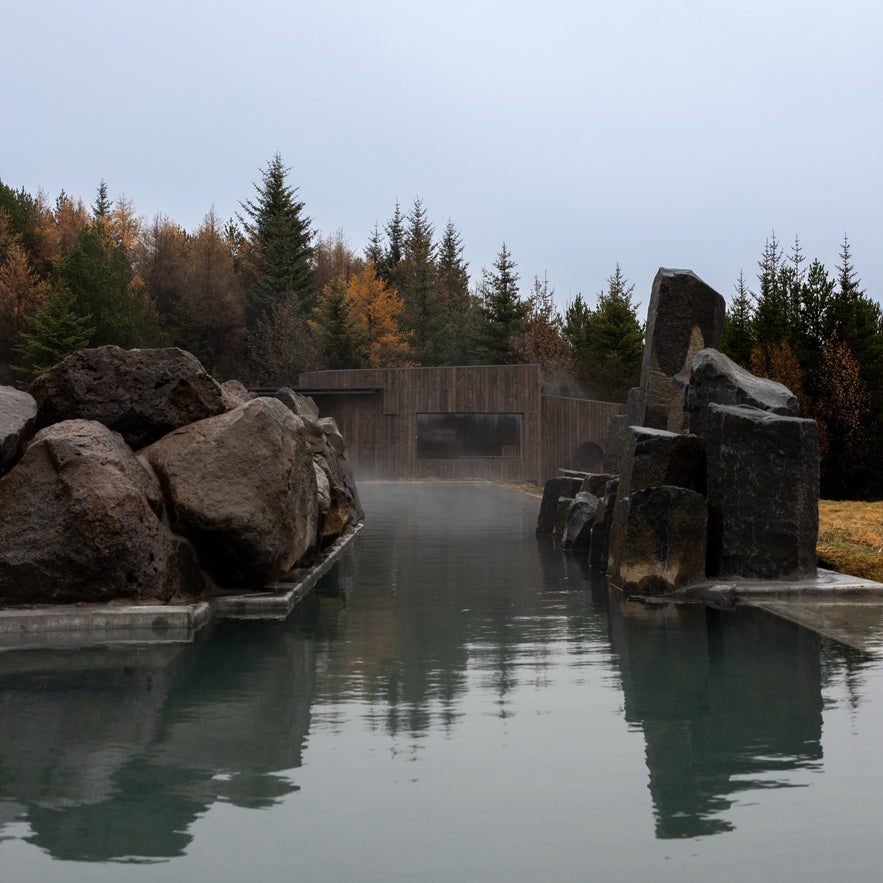 There are three ticket options to choose from at Laugaras Lagoon. The Birki pass is the most affordable and gives you access to the lagoon and its facilities. The Lerki ticket includes perks like a towel and a drink at the bar. Osp pass is the premium choice with a two-course meal and a private changing room.
There are three ticket options to choose from at Laugaras Lagoon. The Birki pass is the most affordable and gives you access to the lagoon and its facilities. The Lerki ticket includes perks like a towel and a drink at the bar. Osp pass is the premium choice with a two-course meal and a private changing room.
The lagoon is in the village of Laugaras, just 18.6 miles (30 km) from Geysir Geothermal Area on Route 35. From Reykjavik, the drive is about 58.4 miles (94 km). Its location makes it a flexible stop, whether for a peaceful start to your Golden Circle adventure or a soothing end after a day of sightseeing.
FAQs about the Golden Circle in Iceland
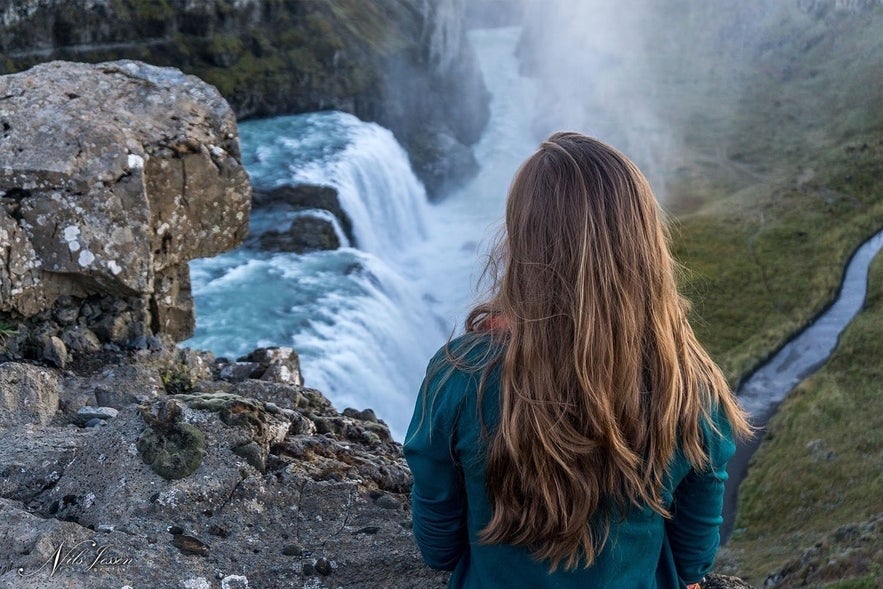
How Far Is the Golden Circle From Reykjavik?
It's a fast and easy drive to Iceland's Golden Circle, just 25 miles (47 km) east of Reykjavik. This is the distance to the closest attraction, Thingvellir National Park.
The furthest of the three attractions is the Gullfoss waterfall, 72 miles (116 km) east of Reykjavik. As you can see from the map of the Golden Circle, the entire route can be traversed in one day, with a return to Reykjavik in the late afternoon or evening.
Where To Stay Near the Golden Circle?
To explore the Golden Circle before the crowds from Reykjavik arrive, consider staying overnight near the area. There is a wide range of hotels and accommodation near the Golden Circle, plus there are campgrounds at Thingvellir National Park and Geysir if you prefer to camp.
Some of the most popular hotels on the Golden Circle Include:
- Read more about Where to stay in Iceland.
When Is the Best Time To See the Golden Circle?
The Golden Circle can be visited at any time of year. Spring, summer, and fall offer milder temperatures, and the landscape is free of snow. If you decide to spend a night near the Golden Circle during the summer, you'll have the opportunity to see these places under the midnight sun with its hues of pink and orange.
In winter, snow blankets the region, offering a unique experience. The water at Gullfoss waterfall continues to run, but parts of the waterfall get frozen, making it seem like glass. This is also a great time to look for the northern lights, or join a northern lights tour in Iceland, to get the best views and insight.
Snow is regularly cleared from the roads. However, sudden storms can cause delays. Be sure to follow the road conditions so you can travel safely.
Choosing when to visit the Golden Circle is more a matter of personal preference than accessibility.
- Discover the Best Time to See the Northern Lights in Iceland.
Why Should You Visit the Golden Circle?
The Golden Circle is a must-visit route in Iceland, offering an easy way to see three iconic attractions in just one day. Whether you join a guided tour or drive yourself, this itinerary combines stunning landscapes, geological wonders, and cultural significance.
Explore Þingvellir National Park, a UNESCO World Heritage Site where you can walk between tectonic plates. Marvel at the powerful Gullfoss waterfall and witness Strokkur geyser’s dramatic eruptions in the Geysir geothermal area. Along the way, discover hidden gems like geothermal baths, local farms, and scenic trails.
With its convenience, natural beauty, and rich history, the Golden Circle is an unforgettable experience for any traveler.
Whether you plan on joining a guided tour or opting for a self-drive, we hope you find our recommendations for the Golden Circle helpful! Have you visited Iceland before? Which sites would you recommend? Share your thoughts in the comment section below!


